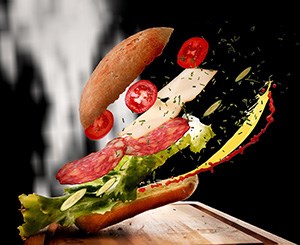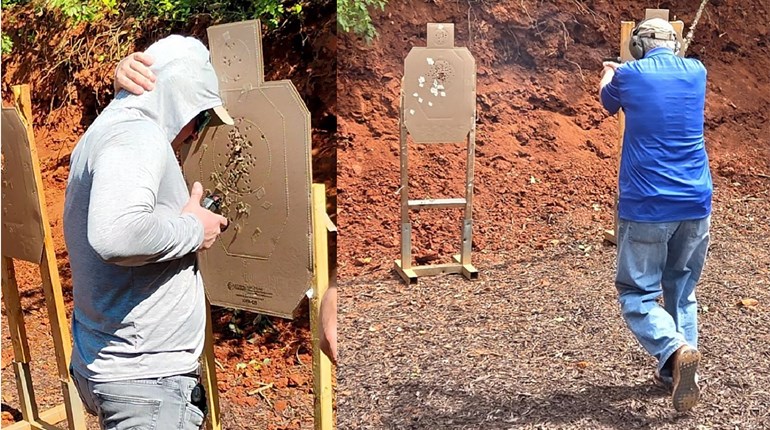
I am so excited to write about The Complete Combatant’s last Reactionary Zone called, “No” time to react, act and respond or the “No Choice” Zone.
In the past three months; Shooting Illustrated has published three articles focusing on the idea of The Complete Combatant’s Four Reactionary Zones.
Part 1 focused on the “Most” amount of time to react, act and respond to a threat. The Most distance is around 25 feet and beyond. We often say that “distance equals time” so this zone gives us the most distance or time, to make a really good first decision.
Part 2 focused on “Some” amount of time to react, act and respond to a threat. We consider 12-25 feet the Somezone. I personally think this is the hardest zone to manage because at 25 feet, you can usually just move with purpose to avoid a threat but as the threat moves closer to you, your decision to avoid needs to be made rather quickly.
Part 3 focused on the “Least” amount of time to react, act and respond to a threat. The Complete Combatant thinks of this zone ranging from 6-12 feet and in this zone, you have “just enough time” to make good first decisions if you are ready for the fight. If you have trained and practiced self preservation options, tool cycling and have pre-made decisions in place then you could be one step ahead of that bad dude.
Now it is time to talk about the final Reactionary Zone, “No” time. Talking about the facts encompassing the “No” time to react, act and respond zone can be very upsetting to some people. It is hard to comprehend that you don’t have time to understand what is happening, make a decision, act on the decision and fully respond to that decision, before the bad guy acts.
When The Supper Club Turns Into Fight Club
 Scenario: You are in a fast food restaurant, you have received your food, and you are now looking for a small table to eat your lunch. You find the perfect spot, and right before you set down your tray, a man appears six feet from you. He says nothing but he is obviously angry, he is sweating, red faced, clenched jaw, tight fists, and is staring a hole through you. You are his target and violence is imminent: What do you do?
Scenario: You are in a fast food restaurant, you have received your food, and you are now looking for a small table to eat your lunch. You find the perfect spot, and right before you set down your tray, a man appears six feet from you. He says nothing but he is obviously angry, he is sweating, red faced, clenched jaw, tight fists, and is staring a hole through you. You are his target and violence is imminent: What do you do?
Before we go any further, let’s give some credit to Edward T. Hall. Edward is a cultural anthropologist that specialized in proxemics that are maintained by healthy, adult, middle-class Americans.
There are several “aspects” of proxemics. The one that Hall writes about is the distance maintained between people when they are communicating. Hall named his four distances: public, social, personal and intimate. We have named ours “Most amount of time to react,” “Some amount of time to react,” “Least amount of time to react” and “No amount of time to react.” In Reactionary Zones Part 4, we will be focusing on The Complete Combatant’s “No time to react” distance.
Per Hall, intimate distance is direct contact. This zone is very easy to explain. You can consider touching, hugging, comforting, football, wrestling and protecting all in this zone. Notice that Hall said “protecting.”
Because of Hall's framework, we know people can feel the pressure of whether that person belongs in a specific zone/space/distance. In self-protection management, we can use his research to our advantage by measuring the violence options available to the bad person while measuring the options available to us to react, act and then respond.
No Time To Lose
Now let’s switch gears from normal healthy adults, to criminals. The No choice Reactionary Zone, which is 6 feet and under from you to the bad guy and gives you no time to react. Not the most, not some, not the least, but no time.
Let’s go over some important things to consider in the No time zone. As always, you want to make one good first decision and then immediately follow up with more good decisions.
First of all, I am not telling you not to react. I am explaining that in this zone there is no time to decipher body language, judge the distance, think about how you want to react, formulate an actual plan and then respond to it when the bad dude coming at you from 6 feet or less.
We call this distance the No choice zone because if they chose violence, you have no choice but to respond, and it will mostly likely be with a “hands on” aka “force on force” action because of the time restraints aka short distance.
- You have no choice but to “manage” him with words, and actions.
- Contextually, he has no right to be there. You are in danger, and this is a threat.
- With all the other thoughts filling our brain, we will not have time to accurately measure distance, which in turn, will measure the time available for us to react, act and respond.
- This is full-action time if the fight is upon us.
- Can you act first? If he is physical first, you may not get a turn to defend yourself.
- Do you have any past force on force training? Do you currently train in ground fighting like jiu jitsu? Now is the time to apply those skills.
- No training? Don’t worry, you will “learn on the job”. Never stop fighting. Never give up.
We have to look at ourselves and ask how did he get this close? Maybe we did not visually manage the space in the Most, Some or Least amount of time Reactionary Zones or we were attacked from behind or ambushed. Your goal is to earn the space to run away or to get to a “tool” to use so you can stop him from doing what he is doing.
Now back to the scenario. You set down your tray and, all of the sudden, a man appears six feet from you. He says nothing but he is obviously angry. He is sweating and red faced, with a clenched jaw and tight fists and is staring a hole through you. You are his target, and violence is imminent.
 Thank goodness you understand that he is under the length of a twin mattress from you, you know that the average stride is 3 feet and that he can cover the distance to you in about half a second. He steps into you and swings at you, but, while screaming, you manage to swing your food tray with all your might and smack him hard in the side of the head. Food goes flying! He was NOT expecting that, so he steps back to regroup. You just bought yourself a bit of time so you step to the side and put the little table between you. These two explosive decisions buys you a bit more time to make more good decisions. He can no longer reach you easily; time is not in his side, so he takes off. You see, he was wrong; you were not an easy target. He was looking to score some cash with little effort from himself, and from you. You made his decision to assault you a bad one, so he has left you to look for another person that may be easier to assault and rob.
Thank goodness you understand that he is under the length of a twin mattress from you, you know that the average stride is 3 feet and that he can cover the distance to you in about half a second. He steps into you and swings at you, but, while screaming, you manage to swing your food tray with all your might and smack him hard in the side of the head. Food goes flying! He was NOT expecting that, so he steps back to regroup. You just bought yourself a bit of time so you step to the side and put the little table between you. These two explosive decisions buys you a bit more time to make more good decisions. He can no longer reach you easily; time is not in his side, so he takes off. You see, he was wrong; you were not an easy target. He was looking to score some cash with little effort from himself, and from you. You made his decision to assault you a bad one, so he has left you to look for another person that may be easier to assault and rob.
You now can take a deep breath. Please consider watching him run away. Which direction does he run? Does he get in a car? What is he is wearing? Now call 911, give them your location and give them as many correct details as you can. Let’s get this guy off the streets.
I had an absolute blast writing Part 1, Part 2, Part 3 and Reactionary Zones Part 4. I am very excited to announce that John Holschen and I will be writing an article together focusing on measuring decisions and reaction times with audio versus visual stimulation.



































